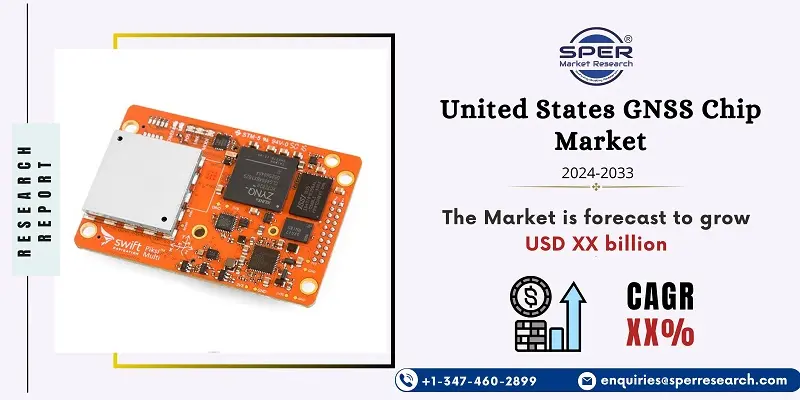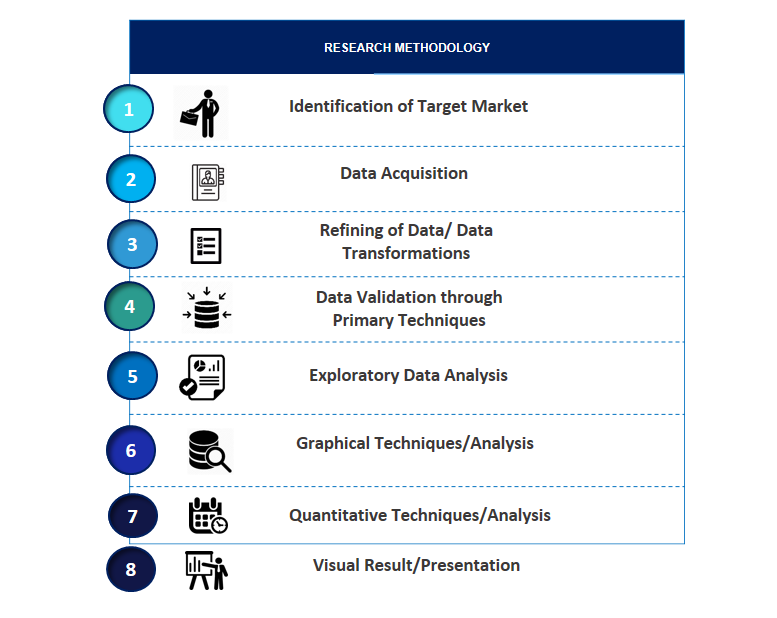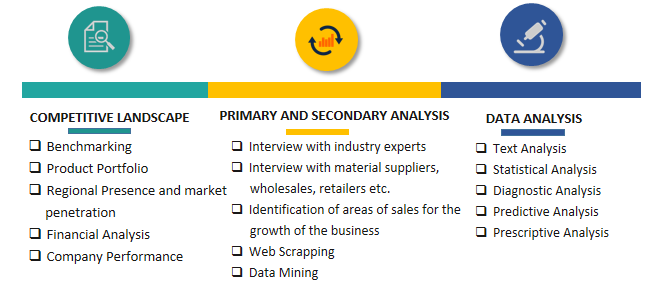
United States GNSS Chip Market Trends, Share, Size, Demand, Revenue and Future Outlook
United States GNSS Chip Market Growth, Size, Trends Analysis- By Device, By Application, By Vertical- Regional Outlook, Competitive Strategies and Segment Forecast to 2033
| Published: Nov-2024 | Report ID: SEMI2432 | Pages: 1 - 109 | Formats*: |
| Category : Semiconductor and Electronics | |||
- October 2021: In order to provide the positioning market with cutting-edge GNSS chipsets and modules, STMicroelectronics unveiled Teseo-VIC3DA, a new member of the Teseo module family. The automotive 6-axis MEMS inertial measurement unit (IMU) and dead reckoning software are combined with ST's high-performance Automotive Teseo III GNSS1 IC to create the straightforward, automotive-qualified navigation module Teseo-VIC3DA.
- September 2021: The BCM4778 is a low power L1/L5 GNSS receiver chip designed for wearable and mobile devices, according to Broadcom Inc. Thanks to the most recent advancements in GNSS, the third-generation chip is 35% smaller and consumes five times less power than the previous version.


| Report Metric | Details |
| Market size available for years | 2020-2033 |
| Base year considered | 2023 |
| Forecast period | 2024-2033 |
| Segments covered | By Device, By Application, By Vertical |
| Regions covered | Eastern Region, Western Region, Southern Region, Northern Region |
| Companies Covered | Qualcomm Incorporated, Broadcom Limited, STMicroelectronics NV, MediaTek Inc., Intel Corporation, U-Blox Holding AG, Skyworks Solutions Inc., Furuno Electric Co. Ltd., Quectel Wireless Solutions Co. Ltd, Others. |
- Automotive Manufacturers
- Defense and Military Organizations
- Smartphone and Wearable Manufacturers
- Agriculture and Farming Enterprises
- Telecommunication Companies
- Logistics and Supply Chain Companies
- Construction and Infrastructure Firms
- Healthcare Providers and Public Health Agencies
- Mapping and GIS Services
| By Device: | |
| By Application: | |
| By Vertical: |
- United States GNSS Chip Market Size (FY’2024-FY’2033)
- Overview of United States GNSS Chip Market
- Segmentation of United States GNSS Chip Market by Device (Smartphones, Tablets, Personal Navigation Devices, In-Vehicle systems, Others)
- Segmentation of United States GNSS Chip Market by Application (Navigation and Location-Based Services, Mapping and Surveying, Telematics, Timing and Synchronization, Others)
- Segmentation of United States GNSS Chip Market by Vertical (Consumer Electronics, Automotive and Transportation, Military and Defense, Marine, Others)
- Statistical Snap of United States GNSS Chip Market
- Expansion Analysis of United States GNSS Chip Market
- Problems and Obstacles in United States GNSS Chip Market
- Competitive Landscape United State GNSS Chip Market
- Impact of COVID-19 and Demonetization United States GNSS Chip Market
- Details on Current Investment in United States GNSS Chip Market
- Competitive Analysis of United States GNSS Chip Market
- Prominent Players in the United States GNSS Chip Market
- SWOT Analysis of United States GNSS Chip Market
- United States GNSS Chip Market Future Outlook and Projections (FY’2024-FY’2033)
- Recommendations from Analyst
1.1. Scope of the report1.2. Market segment analysis
2.1. Research data source2.1.1. Secondary Data2.1.2. Primary Data2.1.3. SPER’s internal database2.1.4. Premium insight from KOL’s2.2. Market size estimation2.2.1. Top-down and Bottom-up approach2.3. Data triangulation
4.1. Driver, Restraint, Opportunity and Challenges analysis4.1.1. Drivers4.1.2. Restraints4.1.3. Opportunities4.1.4. Challenges4.2. COVID-19 Impacts of the United States GNSS Chip Market
5.1. SWOT Analysis5.1.1. Strengths5.1.2. Weaknesses5.1.3. Opportunities5.1.4. Threats5.2. PESTEL Analysis5.2.1. Political Landscape5.2.2. Economic Landscape5.2.3. Social Landscape5.2.4. Technological Landscape5.2.5. Environmental Landscape5.2.6. Legal Landscape5.3. PORTER’s Five Forces5.3.1. Bargaining power of suppliers5.3.2. Bargaining power of buyers5.3.3. Threat of Substitute5.3.4. Threat of new entrant5.3.5. Competitive rivalry5.4. Heat Map Analysis
6.1. United States GNSS Chip Market Manufacturing Base Distribution, Sales Area, Product Type6.2. Mergers & Acquisitions, Partnerships, Product Launch, and Collaboration in United States GNSS Chip Market
7.1. United States GNSS Chip Market Size, Share and Forecast, By Device, 2020-20267.2. United States GNSS Chip Market Size, Share and Forecast, By Device, 2027-20337.3. Smartphones7.4. Tablets7.5. Personal Navigation Devices7.6. In-Vehicle systems7.7. Others
8.1. United States GNSS Chip Market Size, Share and Forecast, By Application, 2020-20268.2. United States GNSS Chip Market Size, Share and Forecast, By Application, 2027-20338.3. Navigation and Location-Based Services8.4. Mapping and Surveying8.5. Telematics8.6. Timing and Synchronization8.7. Others
9.1. United States GNSS Chip Market Size, Share and Forecast, By Vertical, 2020-20269.2. United States GNSS Chip Market Size, Share and Forecast, By Vertical, 2027-20339.3. Consumer Electronics9.4. Automotive and Transportation9.5. Military and Defense9.6. Marine9.7. Others
10.1. United States GNSS Chip Market Size and Market Share
11.1. United States GNSS Chip Market Size and Market Share By Region (2020-2026)11.2. United States GNSS Chip Market Size and Market Share By Region (2027-2033)11.3. Eastern Region11.4. Western Region11.5. Northern Region11.6. Southern Region
12.1. Qualcomm Incorporated
12.1.1. Company details12.1.2. Financial outlook12.1.3. Product summary12.1.4. Recent developments12.2. Broadcom Limited12.2.1. Company details12.2.2. Financial outlook12.2.3. Product summary12.2.4. Recent developments12.3. STMicroelectronics NV12.3.1. Company details12.3.2. Financial outlook12.3.3. Product summary12.3.4. Recent developments12.4. MediaTek Inc.12.4.1. Company details12.4.2. Financial outlook12.4.3. Product summary12.4.4. Recent developments12.5. Intel Corporation12.5.1. Company details12.5.2. Financial outlook12.5.3. Product summary12.5.4. Recent developments12.6. U-Blox Holding AG12.6.1. Company details12.6.2. Financial outlook12.6.3. Product summary12.6.4. Recent developments12.7. Skyworks Solutions Inc.12.7.1. Company details12.7.2. Financial outlook12.7.3. Product summary12.7.4. Recent developments12.8. Furuno Electric Co. Ltd12.8.1. Company details12.8.2. Financial outlook12.8.3. Product summary12.8.4. Recent developments12.9. Quectel Wireless Solutions Co. Ltd.12.9.1. Company details12.9.2. Financial outlook12.9.3. Product summary12.9.4. Recent developments12.10. Others
SPER Market Research’s methodology uses great emphasis on primary research to ensure that the market intelligence insights are up to date, reliable and accurate. Primary interviews are done with players involved in each phase of a supply chain to analyze the market forecasting. The secondary research method is used to help you fully understand how the future markets and the spending patterns look likes.
The report is based on in-depth qualitative and quantitative analysis of the Product Market. The quantitative analysis involves the application of various projection and sampling techniques. The qualitative analysis involves primary interviews, surveys, and vendor briefings. The data gathered as a result of these processes are validated through experts opinion. Our research methodology entails an ideal mixture of primary and secondary initiatives.



Frequently Asked Questions About This Report
PLACE AN ORDER
Year End Discount
Sample Report
Pre-Purchase Inquiry
NEED CUSTOMIZATION?
Request CustomizationCALL OR EMAIL US
100% Secure Payment






Related Reports
Our Global Clients
Our data-driven insights have influenced the strategy of 200+ reputed companies across the globe.




















